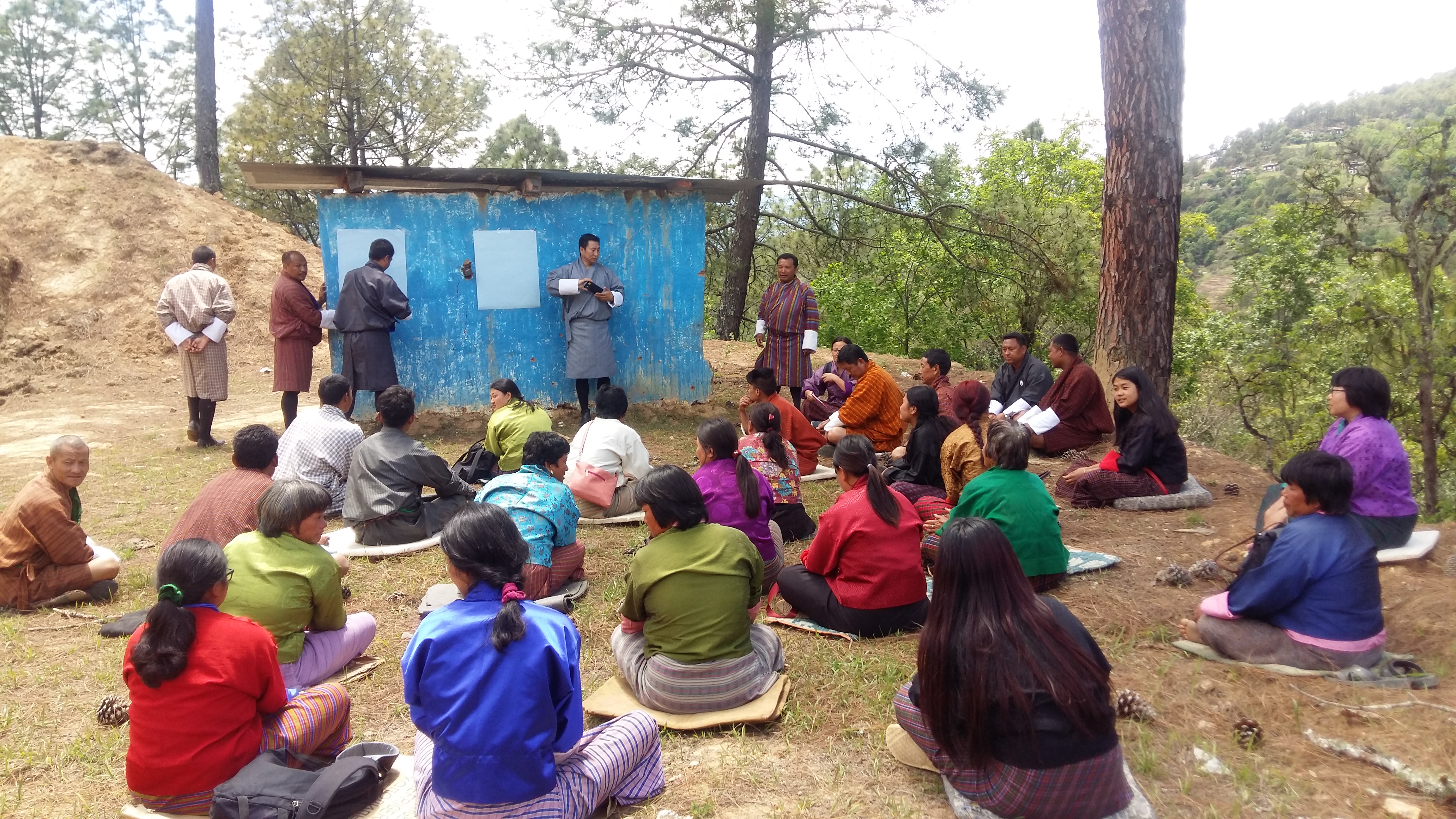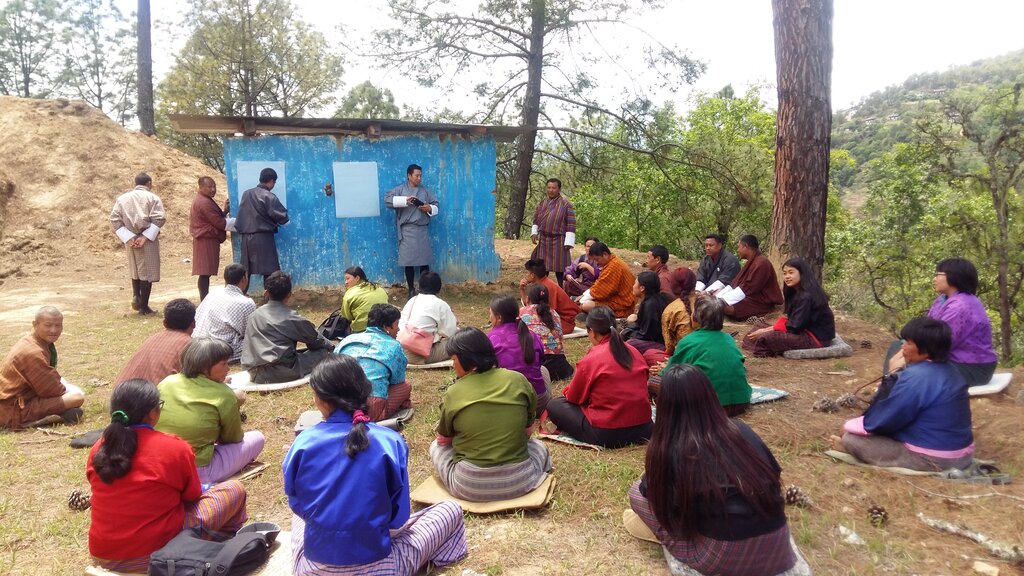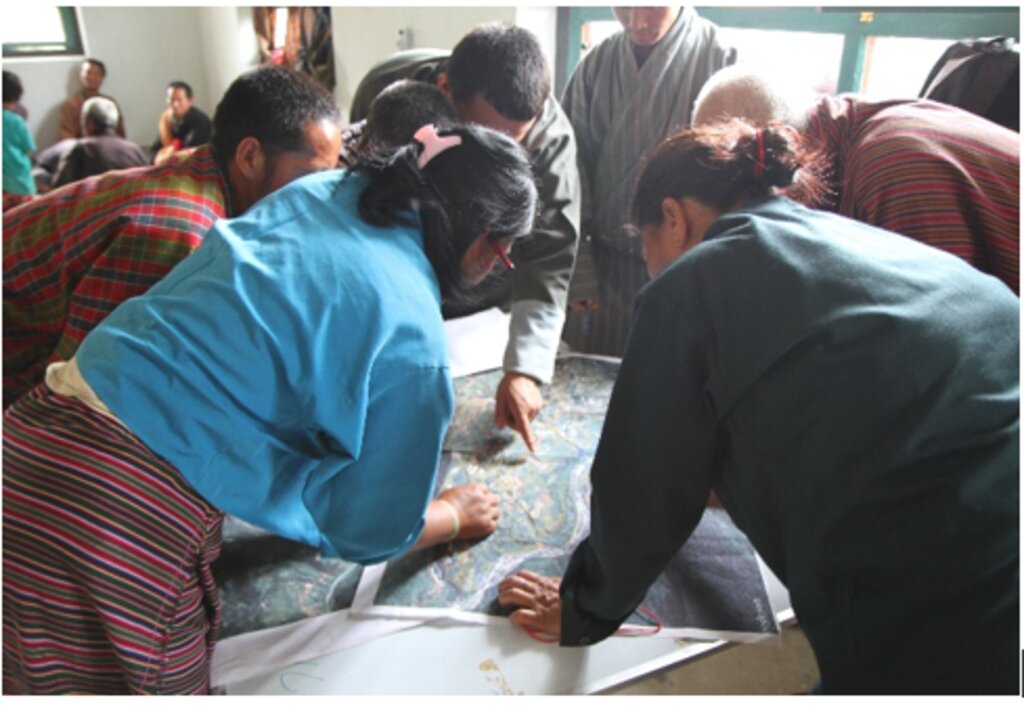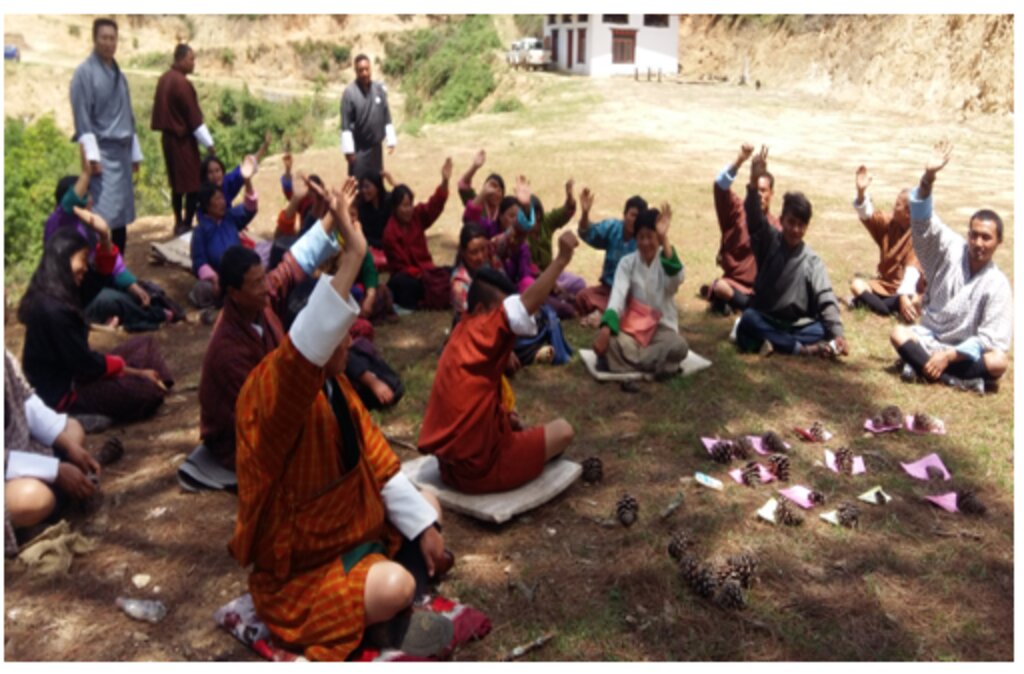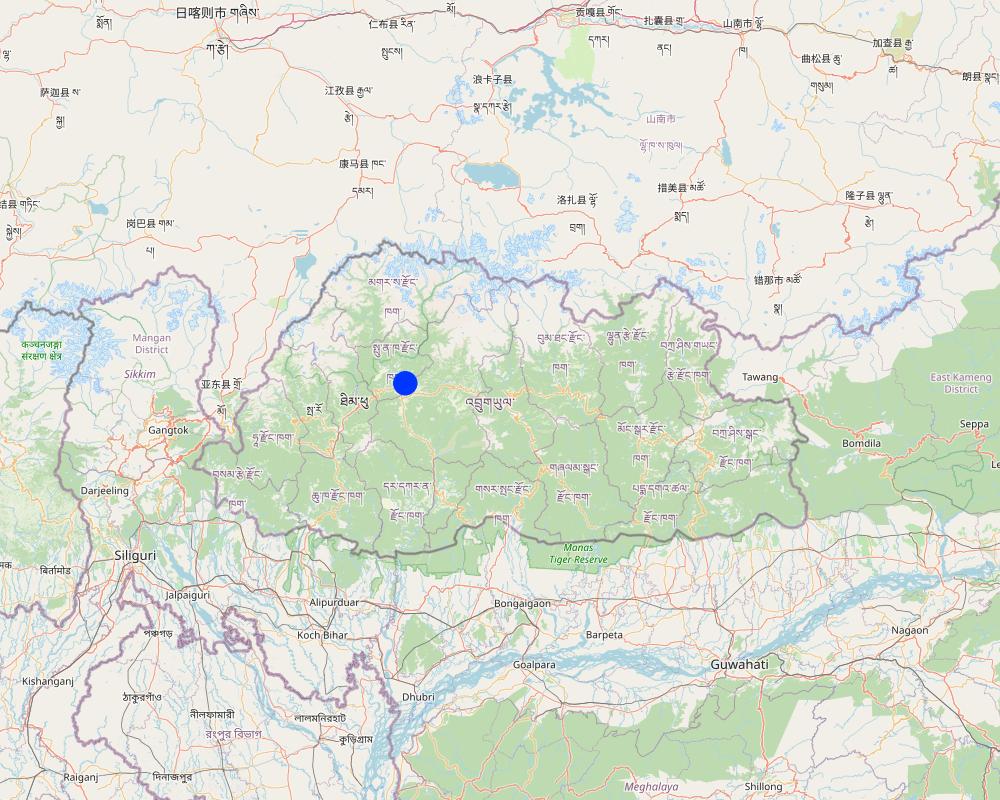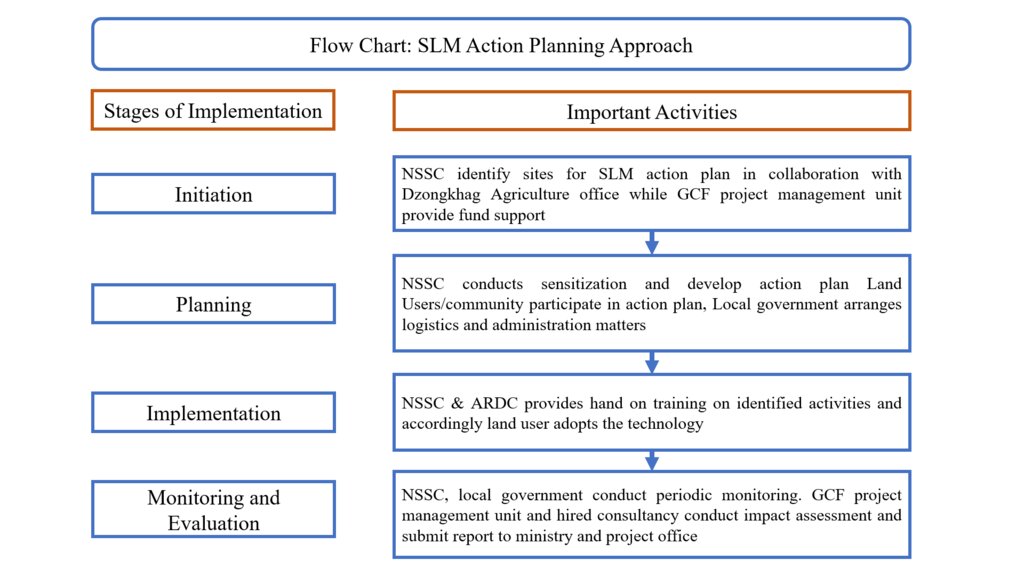Participatory SLM Action Planning [不丹]
- 创建:
- 更新:
- 编制者: Karma Wangdi
- 编辑者: Haka Drukpa
- 审查者: William Critchley, Rima Mekdaschi Studer, Joana Eichenberger
Yuenten Sazhi Zinchong Gi Chharzhi Tsamni Na Chamar Tokni (ཡུན་བརྟན་ས་གཞི་འཛིན་སྐྱོང་གི་འཆར་གཞི་བཙམ་ནི་ནང་བཅའ་མར་གཏོགས་ནི།)
approaches_6819 - 不丹
查看章节
全部展开 全部收起1. 一般信息
1.2 参与方法评估和文件编制的资源人员和机构的联系方式
关键资源人员
土地使用者:
Drukpa Tashi Dorji
17627797
Nabchey
Nabchey་chiwog, Lingmukha gewog, Punakha Dzongkhag
不丹
土地使用者:
Jigme Sonam
77638915
Nabchey
Nabchey chiwog, Lingmukha gewog, Punakha Dzongkhag
不丹
土地使用者:
Dendrup Sonam
77330534
Nabchey
Nabchey chiwog, Lingmukha gewog, Punakha Dzongkhag
不丹
土地使用者:
Wangmo Namgay
17414473
Nabchey chiwog, Lingmukha Gewog, Punakha Dzongkhag
Nabchey chiwog
土地使用者:
Zangmo Kinga
17787383
Nabchey,
Nabchey chiwog, Lingmukha gewog, Punakha Dzongkhag
不丹
有助于对方法进行记录/评估的项目名称(如相关)
Strengthening national-level institutional and professional capacities of country Parties towards enhanced UNCCD monitoring and reporting – GEF 7 EA Umbrella II (GEF 7 UNCCD Enabling Activities_Umbrella II)1.3 关于使用通过WOCAT记录的数据的条件
(现场)数据是什么时候汇编的?:
07/07/2023
编制者和关键资源人员接受有关使用通过WOCAT记录数据的条件。:
是
2. SLM方法的描述
2.1 该方法的简要说明
Participatory SLM action planning is an approach that identifies community-based and land-based issues and challenges, establishes the root causes, and finds out mitigation measures to address the issues for enhancing rural livelihoods.
2.2 该方法的详细说明
该方法的详细说明:
Participatory SLM Action Planning (SLM AP) is a methodology intended to assess potential SLM interventions in order to address the most severe problems of land degradation. Priorities are determined by identifying the main local issues and their root causes, as well as land-based livelihoods and resources. All community households are included in SLM AP, which is conducted at the chiwog (village) levels. It incorporates Participatory Rural Appraisal (PRA) & Participatory Learning Action (PLA) tools such as natural resource mapping, problem censuses, cropping calendars, history lines, prioritization, ranking and ultimately drawing up a realistic SLM action plan. An external resource person facilitates the discussion while the community decides the final action plan. The process is very interactive and focus group discussions are organized specially for facilitating women’s active participation.
Prior to the SLM action planning exercise, sensitization to available SLM technologies is a must. The sensitization program includes pictorial presentations, relevant SLM audio visuals and displaying of SLM posters. After community sensitization on the first day, the actual SLM action planning exercise is conducted the next day. The participants can discuss with their family members and identify which interventions to incorporate in the plan. The stakeholders involved in the planning exercise consists of community members, local leaders, community civil servants and resource persons. The role of the local leader is to identify interventions that benefits the whole community such as community plantations, landslide stabilization along farm roads, community water source protection and a capacity building program for rural livelihood improvements.
Though this is a holistic bottom-up approach, some of the activities may not qualify for endorsement in the final action plan due to a limited budget and high-cost investments with few beneficiaries. The other drawback is that for every action plan, travel of 3 to 4 days is needed in in every chiwog. In general, the SLM action plan consists of individual household plans and a community SLM plan. Therefore, since every household is included and action plans drawn, land users are satisfied with the approach.
2.3 该方法的照片
2.5 采用该方法的国家/地区/地点
国家:
不丹
区域/州/省:
Bhutan
有关地点的进一步说明:
Punakha, Nabchey, Lingmukha
Map
×2.6 该方法的开始和终止日期
注明开始年份:
2020
若不知道准确的年份,请注明该方法的大致开始日期。:
不到10年前(最近)
2.7 方法的类型
- 基于项目/方案
2.8 该方法的主要目的/目标
To assess potential SLM interventions in order to address the most severe problems with land degradation. Priorities are determined by identifying the main local issues and their root causes, as well as land-based livelihoods and resources.
2.9 推动或妨碍实施本办法所适用的技术的条件
社会/文化/宗教规范和价值观
- 启动
Team building, Cooperation
财务资源和服务的可用性/可得性
- 启动
Project support
参与者的的协作/协调
- 启动
All the stakeholders including from chiwog levels to Dzongkhag levels are involved in this approach
了解SLM,获得技术支持
- 启动
They are aware of importance of SLM approaches and any related issues regarding the SLM are reported to gewog extension for further technical assistance.
工作量、人力资源可用性
- 启动
Households helping each other during their work.
- 阻碍
Labor shortages from few households
3. 相关利益相关者的参与和角色
3.1 该方法涉及的利益相关者及其职责
- 当地土地使用者/当地社区
land users
Land users participation in SLM action plan and in program implementation
- SLM专家/农业顾问
Department of Agriculture, National Soil Services Center
Provide technical services, facilitation roles, conducting periodic monitoring and progress reporting
- 地方政府
RNR extension staffs , Gewog administration staffs & Dzongkhag Agriculture staff
Program coordination, technical services and timely reporting
- 国家政府(规划者、决策者)
Project management team
Providing funding support and field monitoring and reporting of project progress
- 国际组织
Green climate fund
Provide financial support and impact assessment
如果涉及多个利益相关者,请注明领导机构:
Green climate fund
3.2 当地土地使用者/当地社区参与该方法的不同阶段
| 当地土地使用者/当地社区的参与 | 指定参与人员并描述活动 | |
|---|---|---|
| 启动/动机 | 互动 | Land users for participation and NSSC for technical support, |
| 计划 | 互动 | Land users, Green climate fund, NSSC, local government |
| 实施 | 互动 | Land users, Green climate fund, NSSC, local government |
| 监测/评估 | 互动 | Local government, NSSC, Project Management Unit |
3.3 流程图(如可用)
3.4 有关SLM技术选择的决策
具体说明谁有权决定选择要实施的技术:
- 所有相关参与者,作为参与式方法的一部分
解释:
After the sensitization on SLM technologies by the NSSC, the land users along with local government decides which technology to adopt considering the local conditions.
明确做出决策的依据:
- 对充分记录的SLM知识进行评估(基于证据的决策)
4. 技术支持、能力建设和知识管理
4.1 能力建设/培训
是否为土地使用者/其他利益相关者提供培训?:
是
明确受训人员:
- 土地使用者
- 现场工作人员/顾问
如果相关,请说明性别、年龄、地位、种族等。:
Both female and male,
培训形式:
- 示范区域
涵盖的主题:
The training consists of in house sensitization and practical demonstration in field. The training topics covers wide range including SLM technologies, Climate resilient practices, group formation for water user association and improved livestock management techniques
注释:
Each person from every household was involved in the training including local government officials.
4.2 咨询服务
土地使用者有权使用咨询服务吗?:
是
指明是否提供了咨询服务:
- 在土地使用者的土地上
- Extension office
说明/注释:
Technical services were provided in the field as well as in meetings.
4.3 机构强化(组织发展)
是否通过这种方法建立或加强了机构?:
- 是,少许
具体说明机构的强化或建立程度:
- 本地
说明机构、角色和职责、成员等。:
Informal labor sharing group were instituted facilitated by gewog extension officers to speed up the implementation of activities especially benefitting whole community such as water user group.
具体说明支持类型:
- 财务
- 能力建设/培训
- 设备
提供进一步细节:
Funds were provided by the project office on annual workplan basis. Technical assistance provided by NSSC/ARDC/Dzongkhag
4.4 监测和评估
监测和评估是该方法的一部分吗?:
是
注释:
Periodic monitoring was conducted by Project management Unit, NSSC, Dzongkhag while evaluation were carried out by private consultancy firms deputed by GCF project head office
若是,该文件是否用于监测和评估?:
是
注释:
The monitoring reports were submitted annually and presented in the workshops for follow ups.
4.5 研究
研究是该方法的一部分吗?
否
5. 融资和外部物质支持
5.1 该方法中SLM组成部分的年度预算
如果不知道准确的年度预算,请给出一个范围:
- 10,000-100,000
注释(例如主要的资助来源/主要捐助者):
This budget is for Punakha, Nabchey, Lingmukha funded by Green climate fund
5.2 为土地使用者提供财政/物质支援
土地使用者是否获得实施该技术的财政/物质支持?:
是
如果是,请具体说明支持的类型、条件和提供者:
Financial support by Green climate fund on SLM technologies 1) Contour stone bunds construction : USD 61.00/per acre 2) Hedgerows: USD 85/acre, 3) Machine terracing: USD 854/acre, 4) Small (1-2 meter wide and depth) Check-dams construction: USD 18/dam .
5.3 对特定投入的补贴(包括劳动力)
- 设备
| 具体说明哪些投入得到了补贴 | 程度如何 | 对补贴做出具体说明 |
|---|---|---|
| 机械 | 充分融资 | Machines for bench terracing |
| 工具 | 部分融资 | Cost sharing (80% by Project, 20% by land user) Green house, |
| fuel | 充分融资 | fueling of government machines for terracing |
- 农业
| 具体说明哪些投入得到了补贴 | 程度如何 | 对补贴做出具体说明 |
|---|---|---|
| 种子 | 充分融资 | Horticulture seeds and seedlings |
| 充分融资 | ||
- 建筑
| 具体说明哪些投入得到了补贴 | 程度如何 | 对补贴做出具体说明 |
|---|---|---|
| 石料 | 部分融资 | stone check-dams (45% by project and 55% by land users |
- 基建
| 具体说明哪些投入得到了补贴 | 程度如何 | 对补贴做出具体说明 |
|---|---|---|
| working lunch for labor | 部分融资 | |
如果土地使用者的劳动力是一项重要的投入,那么是不是:
- 以粮换工
注释:
When materials were freely provided by the project, labor were contributed by beneficiaries, For attending training, working lunch and refreshment were provided by the project
5.4 信用
是否根据SLM活动的方法给予信用值?:
否
5.5 其它激励或手段
是否有其他激励措施或工具用于促进SLM技术的实施?:
否
6. 影响分析和结论性陈述
6.1 方法的影响
该方法是否有助于当地土地使用者,提高利益相关者的参与度?:
- 否
- 是,很少
- 是,中等
- 是,支持力度很大
The decisions were made by the land users and the approach was well received.
这种方法是否有助于基于证据的决策?:
- 否
- 是,很少
- 是,中等
- 是,支持力度很大
Land users were taken for short study visits to successful SLM sites where by decision made was supported by evidence based observation.
该方法是否帮助土地使用者实施和维护SLM技术?:
- 否
- 是,很少
- 是,中等
- 是,支持力度很大
Yes, they still practice and maintain the SLM technologies implemented in their field, however, since SLM interventions were of long term return investment requiring high labor, the adoption rate still remains moderate.
该方法是否提高了土地使用者实施土地管理的知识和能力?:
- 否
- 是,很少
- 是,中等
- 是,支持力度很大
Land users were trained on various technologies and advantages and some progressive farmers were scaling up at larger scale.
Yes, farmers know the importance of SLM technologies, climate change and build resilience to negative impacts
Farmers were forming informal SLM group and working on the farm in groups on rotational basis.
该方法是否有助于社会和经济弱势群体?:
- 否
- 是,很少
- 是,中等
- 是,支持力度很大
As all the financial needs were fulfilled by GCF,
该方法是否改善了性别平等并赋予女性权力?:
- 否
- 是,很少
- 是,中等
- 是,支持力度很大
Women were equally given opportunity to participate in planning and training program.
该方法是否鼓励年轻人/下一代土地使用者参与SLM?:
- 否
- 是,很少
- 是,中等
- 是,支持力度很大
Younger generations were facilitated to take up high tech technologies such as hydroponic, mega green house, drip irrigation and even supported with farm machineries power tillers on cost sharing basis.
该方法是否改善了阻碍SLM技术实施的土地使用权/用户权问题?:
- 否
- 是,很少
- 是,中等
- 是,支持力度很大
Vulnerable agriculture farm lands were brought under SLM
该方法是否改善了粮食安全/改善了营养?:
- 否
- 是,很少
- 是,中等
- 是,支持力度很大
Since vulnerable farm lands were brought under SLM, farmers were able to use farm machines, adopt new techniques which facilitated in improving food security and better nutritional up take.
该方法是否改善了供水和卫生条件?:
- 否
- 是,很少
- 是,中等
- 是,支持力度很大
Improved irrigation water supplies to the farm land
该方法是否提高了土地使用者适应气候变化/极端情况和减轻气候相关灾害的能力?:
- 否
- 是,很少
- 是,中等
- 是,支持力度很大
Since land degradation and Climate change were two side of same coin, the approach had educated the land users on impacts of climate change and accordingly adapt and build resilience.
该方法是否会带来就业、收入机会?:
- 否
- 是,很少
- 是,中等
- 是,支持力度很大
Few school drop outs were able to start a farm enterprise and were able to generate cash income and employment ( vegetable production)
6.2 土地使用者实施SLM的主要动机
- 增加生产
Once vulnerable farm land were brought under SLM, it was easier for land users to crop and maintain.
- 增加利润(能力),提高成本效益比
The land users who adopted short term return technologies such as plastic mulching, green house were able to generate income from sale of vegetables.
- 减少土地退化
The adoption of SLM technologies ( terracing, contour bund) have greatly reduced top soil losses which helped in improving soil fertility and conserving soil moisture.
- 降低灾害风险
The random plantation of grass and tree seedlings along the new farm road cutting sites, check dams construction in gullies and landslide stabilizations works have greatly reduced the risk of major landslide and gully formation.
- 减少工作量
land users workload were drastically reduced through farm mechanization. Even establishment of Napier grass hedgerows have made the work easier for women in collection of fodder for livestock.
- 支付/补贴
Cost sharing mechanism and subsidies payment by Project had also contributed in adoption of SLM technologies to larger scale.
- 加入运动/项目/团体/网络
Project funded all the cost and benefits encouraging people to work in collaboration with government and the project
- 环境意识
Land users were sensitized on negative impacts of environment degradation especially poor management of natural resources and use of excessive fertilizers and chemicals.
- 提高SLM知识和技能
Most of the land users were aware of SLM and its importance.
- 美学改进
SLM technologies such as terracing, hedgerows establishment and contour bund had not only reduced surface soil erosion, but had significantly contributed in beautifying the overall landscape. Even plantation in landslide sites and along new road cuttings sites had stabilized with more green vegetations.
6.3 方法活动的可持续性
土地使用者能否维持通过该方法实施的措施(无外部支持的情况下)?:
- 是
若是,请说明如何维持:
Most of the SLM interventions were of one time investment and maintenance cost were very minimum. The land users will be able to take care and incase of major issues, the funds will be supported by the local government for maintenance such as irrigation channel renovation.
6.4 该方法的长处/优点
| 土地使用者眼中的长处/优势/机会 |
|---|
| The Participatory SLM planning approach is basically putting the farmers first and farmers last. Since the plan is developed by land users, they take full ownership which ensures sustainability of the program. |
| Improved social interaction and cohesion |
| Opportunity for mass sensitization on SLM and climate change to the land users |
| 编制者或其他关键资源人员认为的长处/优势/机会 |
|---|
| Best approach in empowering rural land users. |
| Experts needed to facilitate only |
| Ensures sustainability and successful program implementation |
6.5 该方法的弱点/缺点以及克服它们的方法
| 土地使用者认为的弱点/缺点/风险 | 如何克服它们? |
|---|---|
| Expertise and knowledge gap | consult SLM specialist |
| Elite land users dominating the decision making power | Give equal opportunity to all actors in decision making. |
| Poor participation or un-responsive participants during meetings | Meeting to be attended by head of the household or one who can decide and have decision making power. |
| 编制者或其他关键资源人员认为的弱点/缺点/风险 | 如何克服它们? |
|---|---|
| Difficult to fulfill all demands enlisted in the action plan ( ambitious plan). Some interventions are outside project scope while its of utmost importance to the community such as farm road construction, human wildlife conflicts and new irrigation channel construction requiring high investment. | Sensitization on Project scope, its intended supports and forward the outside project activities to the local government for sourcing funds. |
| Taking program at chiwog level is time consuming and its resource intensive. | Systematic planning and proper budget from initial phase |
| Some land users takes opportunity of the project support though its not much important to them ( free inputs). | Periodic monitoring to ensure the proper utilization. |
7. 参考和链接
7.1 方法/信息来源
- 实地考察、实地调查
1
- 与土地使用者的访谈
1
- 与SLM专业人员/专家的访谈
1
7.2 参考可用出版物
标题、作者、年份、ISBN:
NSSC Bhutan catalogue of soil and water conservation approaches and technologies, 2012
可以从哪里获得?成本如何?
National Soil Service Center, Department of Agriculture, Ministry of Agriculture and Livestock, RGOB.
标题、作者、年份、ISBN:
Agriculture land development guidelines (17th June 2017)
可以从哪里获得?成本如何?
National Soil Service Center, Department of Agriculture, Ministry of Agriculture and Livestock, RGOB.
7.3 链接到网络上可用的相关信息
标题/说明:
Agriculture Land Development Guideline
URL:
www.nssc.gov.bt
链接和模块
全部展开 全部收起链接
无链接
模块
无模块


